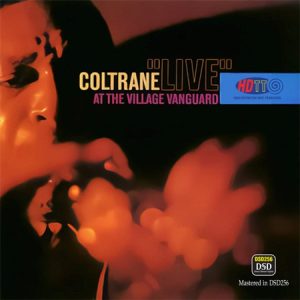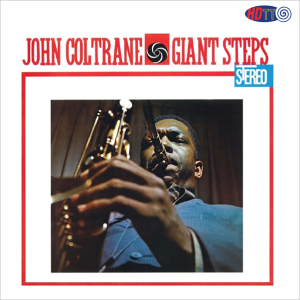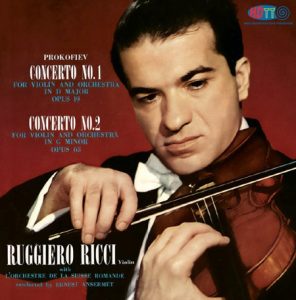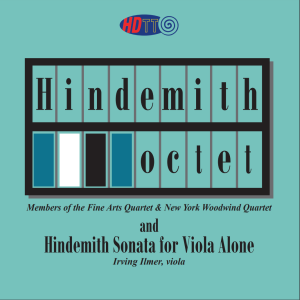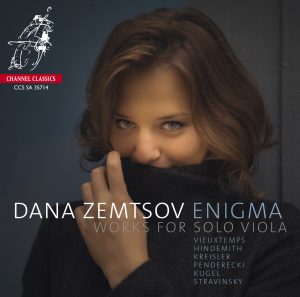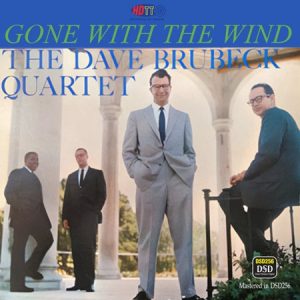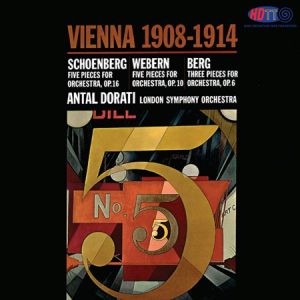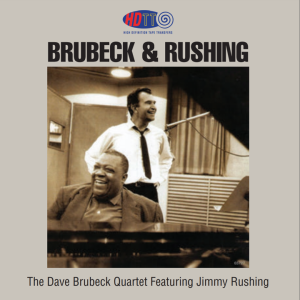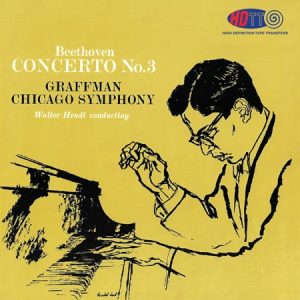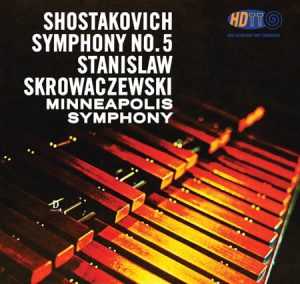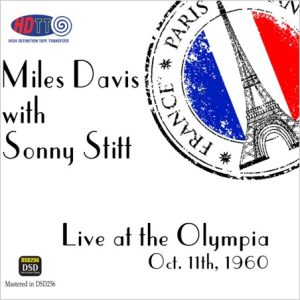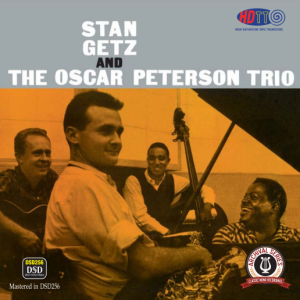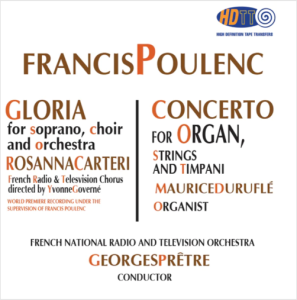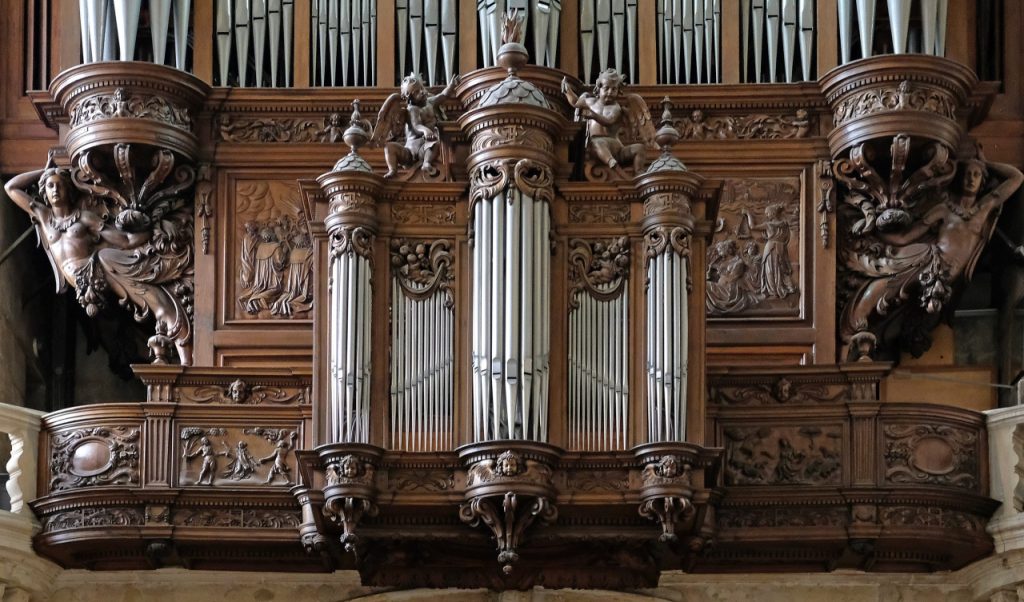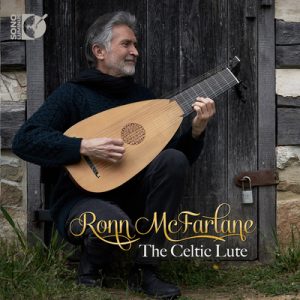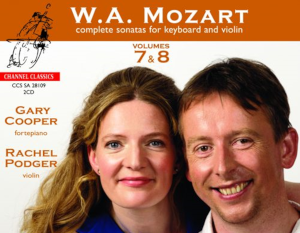Let's talk about new releases from High Definition Tape Transfers (HDTT)—they've been on a roll with great reissues of vintage recordings these last few months. Starting with a classic album from Miles Davis, then two iconic John Coltrane albums, moving along to Getz, Brubeck, Anita O'Day, Jimmy Rushing, and Sonny Stitt. And then to reissues of RCA Living Stereo and Mercury Living Presence albums of Beethoven, Stravinsky, Prokofiev, Hindemith, Schoenberg, Webern, Berg, and Shostakovich. Several releases are Pure DSD256 transfers from 15ips tapes (always welcome), and several are great sounding transfers from mint copies of the original LPs. (See my note about transfers from LP at the end if you've been skeptical.) These reissues are really great music and performances, and the sound quality is superb.
Miles Davis Porgy & Bess. HDTT 1958 2023 (Pure DSD256) HERE
You probably know this Miles Davis & Gil Evans arrangement of this music and the performances on this album. It is a jazz classic. But you've likely never heard it in such excellent sound quality as in this Pure DSD256 transfer from a 15ips 2-track tape. It is without question the best sounding digital transfer this album has seen (no "imo" caveats!). Just get it.
Need I say more? Well..., let me just say that this reissue from HDTT is fantastically, "knock your socks off," good. The timbre of the instruments, the utter transparency of the sound, the dynamics, are simply exceptional. Watch out for those dynamics, by the way. There are some huge swings in volume that will completely overdrive your speakers if you’re not judicious. This is without doubt one of the best Pure DSD256 releases to come from HDTT, and that's saying a lot because they have been providing some marvelous reissues over this past year. So, once again, I simply say "Get it." You won't be disappointed.
John Coltrane, Live at the Village Vanguard. HDTT 1961 2023 (Pure DSD256) HERE
This an absolutely GREAT performance and it is extremely well recorded! Coltrane and company drive with remarkably musical and captivating performances of two great Coltrane tunes, plus a marvelous rendition of Sigmund Romberg’s "Softly as in a Morning Sunrise," all in extended sessions. Including Eric Dolphy on bass clarinet for the opening track, "Spiritual," was a brilliant addition and his contribution is stunningly good. Is this album "one of the greatest live jazz recordings of all time" as sometimes described? Perhaps, I don't know. But it is a MUST HAVE in one's jazz collection.
I only have the CD to which I can compare this HDTT reissue, and it just doesn't stand up to any comparison. The HDTT Pure DSD256 transfer from the tape is superior in all respects—the instruments are more three dimensional, frequencies are more extended, the is much greater openness and airiness to the sound, the proper timbre of the instruments is back, they simply sound so much more like "real" instruments.
In summary, HDTT's Pure DSD256 transfer is exceptionally fine: open, transparent, alive, with excellent rendition of the timbre of the instruments, and a very quiet noise floor. As in other HDTT transfers of jazz recordings, this recording sounds like REAL instruments playing in a real space.
Why did this Coltrane album create such a stir on its release in 1962?
Released February, 1962, Live at the Village Vanguard created such intense controversy that Downbeat’s editor invited Coltrane and Eric Dolphy to "defend" it in print. Even today, some might find "Chasin’ The Trane" hard to hear and hard to comprehend.
Reaction was decidedly mixed with many critics praising the technical capabilities of the performers but criticizing it as overly long, repetitive and difficult to comprehend. Martin Williams of "The Village Voice" praised Coltrane's playing, particularly his intensity and emotional depth, but observed that the album might not be for everyone. (Certainly an understatement!) While John S. Wilson of "The New York Times" praised the album, calling it "one of the most important jazz records of the year."
The performances showcased Coltrane's innovative playing style in which he delivers extended solos, rapid tempo changes, and exploration of new tonal and melodic ideas—they are clearly Coltrane railing to the rooftops, completely unrestrained, and challenging the traditional jazz norms of the time. It was this departure from traditional jazz norms, coupled with Coltrane's tremendous intensity, that both fascinated and challenged listeners, causing a stir in the jazz community.
Yet over time the album has gained acceptance in the mainstream, and it established Coltrane as one of the most influential, if controversial, figures in the history of jazz music.
Giant Steps, by John Coltrane, with Paul Chambers, Art Taylor or Jimmy Cobb, Tommy Flanagan or Wynton Kelly. HDTT 1959 2023 (Pure DSD256) HERE
From a 15ips 2-track tape in a Pure DSD256 transfer. Can you say clean and dynamic? Yes, Coltrane is hard in your right speaker but that's the original Atlantic recording and HDTT has not messed with it. Giant Steps was Coltrane's break-out album. It stands as one of John Coltrane's most iconic and influential works, demonstrating his mastery as a saxophonist, composer, and innovator in the realm of jazz music. I have multiple different releases of this album, but none come close to the superb sound quality of this HDTT transfer in Pure DSD. Many sound processed and dithered with (like the Acoustic Sounds release), others are just bad digital.
This release is a Redux series release from HDTT. There was an earlier DXD release around 2016, but this new release applies improvements in their equipment and processing for significantly improved sound. I've listened to both the earlier release and this, and there is no contest. This new Pure DSD transfer is very much superior in transparency, instrumental timbre and overall naturalness of sound. (The original seems to have been transferred at a bit higher gain setting which can be misleading as to which sounds better. Just take that into account in making your own comparison.) If you love this album, I think you'll find the sonic improvement worth the reinvestment of funds.
Stravinsky Conducts Petrushka, Igor Stravinsky, Columbia Symphony Orchestra. HDTT 1961 2023 (DSD256, DXD) HERE
A wonderful document of how Stravinsky heard his own composition. While I think other conductors may have done better by this work than the composer-as-conductor, this is a "must have" recording for one's music library. Just consider it essential listening. The Columbia Symphony Orchestra provides excellent support to the overall performance. Transferred from a 15ips 2-track tape, the HDTT DSD256/DXD release delivers by far the best sonics of any release of this recording that I've heard. No extraneous noise -- just highly detailed, very clean, very clear sonics with excellent dynamics and very full frequency extension in both bass and treble. Columbia's spot mikes on the orchestral drum surely pay off here! I do not believe you can find a more rewarding release of this performance than this HDTT transfer. Superb job!
Prokofiev Violin Concertos 1 and 2, Ruggerio Ricci, Ernest Ansermet, L'Orchestre De La Suisse Romande. HDTT 1958 2023 (DSD256, DXD) HERE
These dynamic performances of the Prokofiev concertos help one understand why Ruggerio Ricci was considered a lion of his generation. There is power, drive and sinewy strength in these performances. These are not "pretty" renditions, they have grit. And what a pleasure to hear in these superb transfers to DSD256!
Here is yet another example of how well this new series of Vinyl Record Restorations is achieving the goals Bob Witrak set forth. They are clean, highly detailed, full frequency restorations with great dynamics and excellent capture of instrumental timbre. I say, "Bravo!"
Yes, this is a 1958 Blueback LP with all the positives and negatives of that source material. But I've loved these Blueback recordings in my vinyl collection, and I'm delighted to now have them available in these superb digital transfers. And the performance here, as in many other of these early Decca recordings, are competitive with the best in the catalog, even today.
Thank you, HDTT! More please.
Paul Hindemith Octet and Sonata for Viola Alone. Members of the Fine Arts Quartet and New York Woodwind Quintet. HDTT 1960 2023 (DSD256, DXD) HERE
Okay folks, this is buckle up time. Paul Hindemith is not for everyone, but he is for me. And his Octet is terrific music. But, it is not for the faint of heart—have a little affinity in your soul for modern music in order to enjoy this. Performed by two of the pre-eminent chamber ensembles of their day, this is a great performance of the Octet. And Irving Ilmer's performance of the second work on this album, the Sonata for Viola Alone, is masterfully performed. The sound quality is crisp, clean and extremely dynamic. At points, it may be a bit sharpish, presumably due to some fairly close miking, but once you account for that it is not distracting. I cannot suggest more enjoyable or definitive performances of these two works than we have hear. If you think the music may suit your interests, I highly commend this performance and recording to you.
Transferred from a 15ips, 2-track tape, to DSD256 and post-processed in DXD. The original album was released by Concert-Disc in 1960.
And, if you are looking only for a performance of the Sonata for Viola Alone, or viola solo music generally, I suggest you consider the album pictured below by the excellent violist Dana Zemptsov on Channel Classics (HERE). She does not play as emphatically as Ilmer. Instead her playing is more nuanced and seductive. Plus, she adds to the Hindemith additional solo viola pieces by Stravinsky, Vieuxtemps, Penderecki, Kreisler, and Bach. It is a delicious album.
See above for comments.
Anita Sings the Most, Anita O'Day, The Oscar Peterson Quartet. HDTT 1956 (mono) (Pure DSD256) HERE
Here is Anita O'Day in perhaps one of her best studio recordings, together with superb accompaniment by the Oscar Peterson Trio. The smaller ensemble seems a perfect match for her. O'Day's treatment of the music, from ballads to swing, is classic and shows why she was so highly regarded. Peterson, Brown and Ellis, supplemented here by drummer John Poole, are spot on as they support and complement her.
Transferred from a 15ips 2-track tape in Pure DSD256, with no PCM, the sound quality of the transfer is similarly spot on—clean, transparent, detailed, and slightly warm. It is simply beautiful. I compared this HDTT transfer to a Japanese SACD, which was not a kind comparison to the SACD. The SACD was clean, yes. But the HDTT transfer sounded more like real instruments, bringing much more of that warm, complex textured analog magic to the overall sound quality of instruments and voice. Just decidedly superior.
If you're not familiar with Anita O'Day, you owe it to yourself to explore her music. She had a distinct and memorable vocal style characterized by clarity, agility, and improvisational skill that allowed her to effortlessly navigate complex melodies and rhythms. She was known for her versatility and ability to interpret a wide range of musical genres, including swing, bebop, ballads, and Latin jazz. Her natural sense of phrasing and timing allowed her to bring out the emotional depth of a song. She often scatted, and while Ella Fitgerald may rightfully be considered the queen of scat, O'Day brought a rhythmic precision and creative use of syllables that made her scat singing different and captivating.
There is no better place to get to know her than right here in Anita Sings the Most.
Gone With The Wind, The Dave Brubeck Quartet. HDTT, 1959 2023 [Pure DSD256] HERE
This was the eighth studio album by the Dave Brubeck Quartet and features the classic lineup of Dave Brubeck on piano, Paul Desmond on alto saxophone, Eugene Wright on double bass, and Joe Morello on drums. It may not be as widely recognized as some of their other albums, but it is a very enjoyable adventure with the quartet's melodic improvisation, intricate harmonies, and rhythmic exploration. What I most enjoy about this album is how it showcases the quartet's ability to reimagine familiar melodies with unique jazz improvisations and arrangements.
The name of the album comes from the closing track—a jazz interpretation of the theme from the 1939 film "Gone With The Wind" which is often called "Tara's Theme," written by Max Steiner. Other classics are also included, such as "Georgia on My Mind," "Camptown Races," "Jeepers Creepers," and "Short'nin' Bread" in which call-and-response exchange between Morello's drums and Brubeck's piano is a pure treat to hear. When Desmond and Brubeck toss a brief snippet from "Blue Rondo à la Turk" into their performance of "Gone with the Wind," I get a big silly grin on my face—they are just having so much fun.
The sound of this release is that of many excellent studio Columbia jazz recordings—detailed, well balanced, great instrumental tone, and excellent dynamics. (Why Columbia could capture such excellent sound quality in their jazz releases, but such middling sonics in the classical releases, has always been one of my frustrations.) This transfer by HDTT is taken from a 15ips 2-track tape directly to Pure DSD256 with no PCM post-processing, and it sounds as clean, sweet and open as one might possibly hope to hear. Just immensely well done.
Vienna 1908-1914, Music of Schoenberg, Webern and Berg, Antal Dorati, London Symphony Orchestra. HDTT 1962 2023 (DSD256, DXD) HERE
This album has long been a favorite of mine. It includes three of the most significant and influential orchestral compositions of the early twentieth century, all written in Vienna within a six year span from 1908-1914. Schoenberg, Webern and Berg shared an interest in moving beyond traditional tonality. These compositions were ground breaking at the time were published. And they played a crucial role in reshaping the course of Western classical music. By placing all three on the same album, we get to hear works that are stylistically different, but all pointed in a similar direction of breaking out of the traditional mold for constructing classical music.
Webern and Berg were both students and close associates of Schoenberg. Together, the three were the pioneers of atonal and twelve-tone composition. They pushed the boundaries and were definitely the "bad boys" of Vienna at the time.
And yet, to our modern ears, these very innovative and challenging compositions sound rather tame in many respects. Schoenberg's work, in particular, is very approachable today and it can be a great entry point from which to begin appreciating his works. It is his pivotal point of departure from traditional tonality, but is easily digestible and, for me, very enjoyable.
Webern, by turn, delivers to us a work of great brevity and concentration. He moves even further towards abstraction and reduction than Schoenberg did.
And then with Berg we get a continuation, but a bit of variance. As here in his Three Works for Orchestra, op. 6, Berg's compositions often exhibit more romantic and lyrical qualities compared to the works of Schoenberg and Webern, even while reflecting the strong influences of his two associates. Both Berg and Webern embraced the twelve-tone technique pioneered by Schoenberg, but their approaches to serialism differed. Berg favors a looser application, allowing for more expressive freedom. Webern, on the other hand, tends to be more strict and systematic in his approach to serialism.
There is a lot to absorb in this album, and even more to enjoy.
The sound quality is some of the best recorded orchestral sound achieved by the Mercury Living Presence team. Master recording engineer Robert L. Fine is clearly at the top of his game in this 1962 recording. The orchestral sound is BIG, DYNAMIC, IMPACTFUL. It's why many of us so much enjoy these early Mercury Living Presence original pressings. And in this digital capture from the analog source, Bob Witrak has captured the sonics with all the color, presence, detail and dynamics that one might hope for. It is a gorgeous new reissue of a classic recording.
Oh, did I mention this is a needle drop? Yes, it is. And it is terrifically good. Transferred from an original Mercury Living Presence LP, it puts the CD reissue of this album to shame. Incredibly, it sounds very much like my recollection of the sound of the excellent Speakers Corner 3-LP reissue I used to play on my Walker Audio Proscenium turntable. And, yes, it does sound like the LP, not like a tape and like not a modern DSD256 recording. It has that slightly dark overall sound of the original LPs—very faithfully captured in the transfer. And, since I've always liked the original Mercury LPs, I couldn't be happier with the sound HDTT is delivering in this vinyl LP transfer: fully true to the original, their fourth release in this new Vinyl Record Restoration series.
Highly recommended all around. May there be many more!
P.S., If you take a look at the HDTT web page for this album and look at the customer reviews, you will see three Five Star reviews (including mine), each commenting on the excellent sound quality of this release. My review, posted when this was first released, currently has 7 Dislikes. The same is true of my review of the other Mercury LP transfer of Skrowaczewski's performance of Shostakovich's Fifth, currently with 5 Dislikes. Hmmm, a pattern of orchestrated disses on the Mercury LP transfers? Amazing! And don't believe them—listen for yourself.
Brubeck & Rushing, The Dave Brubeck Quartet featuring Jimmy Rushing. HDTT 1960 2020 (DXD) HERE
This album is just so much fun! As I was listening to it again today, I thought I should really include a comment about it. As explained in the enclosed booklet, Jimmy Rushing was known as "Mr. Five By Five"—an affectionate reference to his height and girth—a blues shouter who defined and then transcended the form. The owner of a booming voice that radiated sheer joy in whatever material he sang, Jimmy Rushing could swing with anyone and dominate even the loudest of big bands. Rushing achieved his greatest fame in front of the Count Basie band from 1935 to 1950, yet unlike many band singers closely associated with one organization, he was able to carry on afterwards with a series of solo recordings that further enhanced his reputation as a first-class jazz singer.
On ten standards, Brubeck, alto saxophonist Paul Desmond and the Quartet fit in perfectly behind this great swing/blues singer. It's truly a swingin' affair.
The sound quality of this HDTT transfer is excellent. Comparing it to the Columbia CD, the sound of the HDTT release brings all those better sonic characteristics I've come to expect: the instruments sound more real, there is greater texture and more accurate timbre. The CD may be arguably "cleaner" but the sound is also much more two-dimensional and lacking the more extended harmonic overtones and air of the HDTT release that make everything sound just so much more real. It's the paper-cutout, not the real thing. If you have the CD, I won't make a compelling argument that you need to get the HDTT, but if you're currently thinking about acquiring this album in digital form, do yourself a favor and get this DXD HDTT release.
Beethoven Piano Concerto No. 3, Gary Graffman, Walter Hendl, Chicago Symphony Orchestra. HDTT 1960 2023 (DSD256, DXD) HERE
Nice, full orchestral sound with the great Chicago Symphony Orchestra in its prime. The piano is spotlighted (as tended to happen in this era of recordings), but otherwise all is very much RCA Living Stereo excellence under the judicious oversight of producer Richard Mohr.
As I listen, I’m liking this release quite a lot. The sound is very clean, very open, and very detailed, with great weight and impact from both piano and orchestra. The release may sound a bit "sharpish" in the top end, but the clarity is indisputable. Don’t expect it to sound like a Shaded Dog LP, it doesn’t. But It does sound like an excellent 15ips tape with all the characteristic differences of R2R tape versus vinyl. I don’t have another digital release of this album against which to compare this high resolution DXD/DSD256 transfer from tape, but the usual excellence we’ve come to expect of HDTT’s releases is fully evident here.
Shostakovich Symphony No. 5, Stanislaw Skrowaczewski, Minneapolis Symphony. HDTT 1961 2020 (DSD256, DXD) HERE
This new release in the VRR series of hi res transfers from LP is very, very nice: clean, detailed, very open sounding, with great dynamics. The growling detail of the double bass strings and the low brass, the resonance of the orchestral drum when struck, the sharp transients of percussion, or delicate pluck of harp are all things of beauty to hear. The soundstage is very well captured, with excellent breadth and scale. Bob Witrak is really hitting on the mark with these Mercury LP transfers, in my opinion. With both this release and the earlier Vienna: 1908-1914 release, his vinyl playback setup is performing very nicely (said by a long time vinyl fanatic). And the DSD256 transfer seems to be capturing all of it (as far as I can tell without hearing the LP live on his system). If you have been hesitating about this VRR series, this release is a great one to take a chance with. I'm loving it, and it is soooo much better than the CD reissue from 2007 that I have to compare. In the HDTT reissue, the instruments once again sound like real instruments with excellent reproduction of timbre and dimensionality, not paper cutouts.
In case you are not familiar with this Mercury Living Presence recording, let me start by saying it is one of the top Living Presence releases and highly prized for both music, performance and recording quality. If your preference is for the "heart on your sleeve" racing pace of the Bernstein recording, this recording may not be to your preference. But if you prefer, or at least are willing to explore, a more introspective approach and one which explores the more devilish side of Shostakovich's subversive writing, you will enjoy this performance. Indeed, among the many, many performances of this work I have in my music library, I rank this among the top 3 or 4. I'll not go into the background and various interpretations of Shostakovich's intent in this work. Suffice it to say that I think Skrowaczewski comes closer to giving us the mind of Shostakovich in this work than many other conductors.
This is a recording and performance that should be in every classical music library!
Miles Davis And Sonny Stitt Live At The Olympia. HDTT 1960 2023 (Pure DSD256) HERE
This is a high energy, raw and raucous session. The recording has great impact, and a moderate adjustment downward of my volume control was needed to prevent my speakers from being over driven in places by the huge amount of energy from trumpet and saxophone that is captured here. Even with the slightly lower volume setting, I felt almost present in front of the stage. There is a very slight lack of transparency through the midrange that holds this album back from echelons of the best, but, overall, this recording is a DEFINITE THUMBS UP. And the interplay of Davis and Stitt as they improvise in, out and around each other, is just a great musical experience.
From a 15ips 2-track tape transferred directly to DSD256 with no PCM—about as pure a copy of the original tape as any of us are like to hear.
Stan Getz And The Oscar Peterson Trio. HDTT 1958 2023 (Pure DSD256) HERE
On October 10, 1957, the legendary saxophonist Stan Getz met with the Oscar Peterson Trio at the Verve Records studio in Hollywood. The result of their performances together that day is this iconic album released in 1958.
The recording session captured some incredible chemistry as they improvised together over a number of classic standards and popular tunes, including "I Want to Be Happy," "Pennies from Heaven," and "Ballad Medley." Stan Getz on tenor saxophone complements the exceptional jazz talents of Oscar Peterson on piano, Ray Brown on bass, and Herb Ellis on guitar.
No one played the "star." It was a collegial gathering of musicians who respected one another and could simply enjoy making music together. They demonstrate a deep understanding of each other's playing styles and the result are cohesive and captivating performances aptly reflect this collegiality. It is a testament to the musicianship of all involved. It's is also one of the classics in the jazz genre and belongs in every collection.
The sound of this mono 15ips tape is simply gorgeous in this pristine Pure DSD256 transfer. No PCM, no post processing, just the virtually indistinguishable sound of the original source tape. Highly recommended if you value small ensemble jazz.
Poulenc Gloria and Concerto For Organ, Strings And Timpani, Georges Prêtre, Rosanna Carteri, Maurice Duruflé, French National Radio and Television Orchestra. HDTT 1961 2023 (DSD256, DXD) HERE
This recording from 1961 of the Poulenc Concerto for Organ, Strings and Timpani has long been my favorite recording of this massive work. Prêtre and Duruflé deliver a simply stunning performance recorded in the Church Saint-Étienne-du-Mont where Duruflé held the post of Titular Organist from 1929 until his death in 1986. Other recordings of this work lack the energy and very French flavor of this performance. Plus, they don't have the marvelous Cavaillé-Coll organ which makes this recording so persuasive.
The performance of Poulenc's Gloria is similarly very fine, in many way sui generis. Prêtre again delivers unique French flavor to this work along with the excellent singing by soprano Rosanna Carteri. But, the clarity of the chorus sometimes gets lost in the reverberation of the church. Still, the overall performance is thrilling. And, yet, I get the album for the Concerto for Organ and the marvelous playing of Maurice Duruflé.
HDTT's transfer from a 15ips 2-track tape provides the best sonics of any release of these performances that I can recall hearing. This transfer is very clean, very open, with excellent resolution, and great dynamic range. It is a wonderful gift that I'm delighted to have once again in my music library. Any fan of Poulenc's music, or of organ, must have this recording. I highly recommend it.
The organ of the tribune of Église Saint-Étienne-du-Mont, Paris. (Photo by Diliff, courtesy of Creative Commons)
Case of the organ of the tribune of Église Saint-Étienne-du-Mont, Paris, installed in 1633. Organ rebuilt in 1863 by Cavaillé-Coll, with further revision by Beuchet-Debierre in 1956. (Photo by Mbzt, courtesy of Creative Commons)
Addendum: What's the story with HDTT's transfers from LP?
Needle drops. Oh, the horror. Isn't HDTT starting from a step back in the audio continuum by transferring from vinyl?
No! Don't be misled by your and other's preconceptions!
HDTT has now released seven albums in its new Vinyl Records Restoration (VRR) series, two of which are the Mercury Living Presence releases included among the albums reviewed in this article. Given the varied reactions I've seen to this series, I thought I'd share a bit of my perspective about these vinyl transfers.
I come to digital playback from many years listening to vinyl on the immensely capable Walker Audio Proscenium air bearing turntable. This turntable continues to be Positive Feedback's Editor in Chief's listening reference tool (see David's summary HERE). Over my years listening to vinyl, I heard some of the most incredibly detailed, high resolution sound that consistently amazed me with its quality. Vinyl is no slouch in terms of the amount of detail and resolution contained in its grooves.
Yes, when we start from vinyl to create a digital file, there are now multiple generations of "stuff" between us that the edit master tape. But, an original pressing LP was made when the analog tapes were fresh. And, in the case of the Mercury Living Presence LPs, the mastering was done by the immensely capable and respected George Piros using tapes as close to the original session tapes as anyone has ever been able to use. Today, the tapes George Piros was able to use are old and, in many cases, no longer even playable.
Plus, the commercial tapes released by Mercury tended to be of the gang-processed at higher speed variety, so the sound quality of those commercially released tapes is not as wonderful as some of the tapes released by a few other labels, particularly jazz tapes.
But, my point is that there is no reason why the sound of a digital transfer from LP, using today's technology, won't be indistinguishable in sound quality from that source LP.
With Bob Witrak applying his state-of-the-art digital transfer technology, and applying his immense knowledge of how to get a great sounding digital file from an analog source, the results should be, AND ARE, immensely satisfying sonically.
These are not your garden variety needle drops. They are made using Merging Technology analog to digital converters (recording studio quality) and judicious post processing to subtly clean up the resulting transfers. The backgrounds are silent (there is no groove noise), and the detail and dynamics are as good as I've heard from any LPs on my former vinyl playback system. These releases sound like the original issue LPs from which they are transferred.
And, importantly, Bob spends a tremendous amount of effort finding his source LPs from which to make a transfer. He rejects many copies before finding a pressing that meets his standards for a source LP. This is no different than the effort he puts into finding the source tape from which he's willing to make a transfer. So, not only are these not your garden variety needle drops—the pressings used as the source are not your garden variety off-the-shelf pressing. Those of you who have gone through multiple copies of an LP to find that one pressing that sounds really good will understand the compulsion (as I do).
If you liked the original LPs played on your vinyl playback system, you should like these VRR series transfers if your digital playback system is up to snuff.
Note: In the VRR series we are, of course, listening to Bob's vinyl playback system. His choices of equipment may not be your choices. But, at the same time, whenever we listen to a transfer from analog tape, we are also listening to someone's choice in playback system. Tape player electronics and setup vary all over the map. Don't fool yourself into thinking that tape is a neutral standard that sounds the same from every source. It does not. The electronics in the tape preamps differ, the magnetic heads differ, the transports differ, the alignments differ, the bias settings differ—it all affects the sound such that a transfer from one system will not sound identical to a transfer from another system. Each reflects the sonic and aesthetic choices being made by the person who put together that system. My choice: just enjoy the excellent vinyl playback system Bob has assembled and continues to tweak and upgrade.





